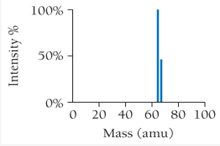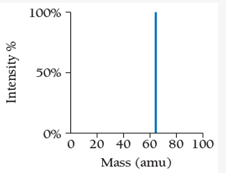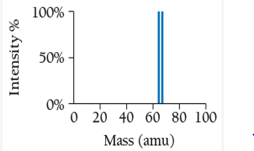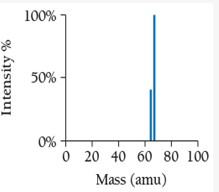
Chemistry: Structure and Properties
1st Edition
ISBN: 9780321834683
Author: Nivaldo J. Tro
Publisher: PEARSON
expand_more
expand_more
format_list_bulleted
Concept explainers
Textbook Question
Chapter 1, Problem 11SAQ
Copper has an
Expert Solution & Answer
Want to see the full answer?
Check out a sample textbook solution
Students have asked these similar questions
Check the box under each structure in the table that is an enantiomer of the molecule shown below. If none of them are, check the none of the above box under
the table.
Molecule 1
Molecule 2
IZ
IN
Molecule 4
Molecule 5
ZI
none of the above
☐
Molecule 3
Х
IN
www
Molecule 6
NH
G
Highlight each chiral center in the following molecule. If there are none, then check the box under the drawing area.
There are no chiral centers.
Cl
Cl
Highlight
A student proposes the following two-step synthesis of an ether from an alcohol A:
1. strong base
A
2. R
Is the student's proposed synthesis likely to work?
If you said the proposed synthesis would work, enter the chemical
formula or common abbreviation for an appropriate strong base to use
in Step 1:
If you said the synthesis would work, draw the structure of an alcohol
A, and the structure of the additional reagent R needed in Step 2, in
the drawing area below.
If there's more than one reasonable choice for a good reaction yield,
you can draw any of them.
☐
Click and drag to start drawing a structure.
Yes
No
ロ→ロ
0|0
G
Х
D
: ☐
ப
Chapter 1 Solutions
Chemistry: Structure and Properties
Ch. 1 - Which statement is true about matter? a) Matter is...Ch. 1 - A chemist mixes sodium with water and witnesses a...Ch. 1 - Two samples of a compound containing elements A...Ch. 1 - A compound containing only carbon and hydrogen has...Ch. 1 - Which concept was demostrated by Rutherford’s gold...Ch. 1 - A student re-creates Millikan’s oil drop...Ch. 1 - Prob. 7SAQCh. 1 - An isotope of an element contains 82 protons and...Ch. 1 - How many electrons are in the Cr3+ ion? 24...Ch. 1 - A naturally occurring sample of an element...
Ch. 1 - Copper has an atomic mass of 63.55 amu and two...Ch. 1 - Which sample contains the greatest number of...Ch. 1 - Explain this statement in your own words and give...Ch. 1 - Explain the main goal of chemistry.Ch. 1 - What are two different ways to classify matter?Ch. 1 - How do solids, liquids, and gases differ?Ch. 1 - Explain the difference between a pure substance...Ch. 1 - Explain the difference between an element and a...Ch. 1 - Explain the difference between a homogeneous and a...Ch. 1 - Describe the scientific approach to knowledge. How...Ch. 1 - Prob. 9ECh. 1 - What observations did Antoine Lavoisier make? What...Ch. 1 - What theory did John Dalton formulate?Ch. 1 - What is wrong with the expression, “That is just a...Ch. 1 - Summarize the history of the atomic idea. How was...Ch. 1 - Prob. 14ECh. 1 - State and explain the law of definite proportions.Ch. 1 - State and explain the law of multiple proportions....Ch. 1 - What are the main ideas in Dalton’s atomic theory?...Ch. 1 - How and by whom was the electron discovered? What...Ch. 1 - Explain Millikan’s oil drop experiment and how it...Ch. 1 - Prob. 20ECh. 1 - Describe Rutherford’s gold foil experiment. How...Ch. 1 - Describe Rutherford’s nuclear model of the atom....Ch. 1 - If matter is mostly empty space, as suggested by...Ch. 1 - List the three subatomic particles that compose...Ch. 1 - What defines an element?Ch. 1 - Explain the difference between Z (the atomic...Ch. 1 - Where do elements get their names?Ch. 1 - What are isotopes? What is percent natural...Ch. 1 - Describe the two different notations used to...Ch. 1 - Prob. 30ECh. 1 - Prob. 31ECh. 1 - Explain how a mass spectrometer works. What kind...Ch. 1 - Each shape represents a type of particle (such as...Ch. 1 - Using triangles to represent one type of atom and...Ch. 1 - Classify each substance as a pure substance or a...Ch. 1 - Classify each substance as a pure substance or a...Ch. 1 - Prob. 37ECh. 1 - Complete the table. Substance Pure or mixture Type...Ch. 1 - Determine whether each molecular diagram...Ch. 1 - Determine whether each molecular diagram...Ch. 1 - Classify each statement as an observation, a law,...Ch. 1 - Classify each statement as an observation, a law,...Ch. 1 - A chemist decomposes several samples of carbon...Ch. 1 - When astronomers observe distant galaxies, they...Ch. 1 - Prob. 45ECh. 1 - An automobile gasoline tank holds 21 kg of...Ch. 1 - Two samples of carbon tetrachloride are decomposed...Ch. 1 - Two samples of sodium chloride are decomposed into...Ch. 1 - The mass ratio of sodium to fluorine in sodium...Ch. 1 - Upon decomposition, one sample of magnesium...Ch. 1 - Two different compounds containing osmium and...Ch. 1 - Palladium forms three different compounds with...Ch. 1 - Prob. 53ECh. 1 - Sulfur and fluorine form several different...Ch. 1 - Which statements are consistent with Dalton’s...Ch. 1 - Which statements are inconsistent with Dalton’s...Ch. 1 - Which statements are consistent with Rutherford’s...Ch. 1 - Which statements are inconsistent with...Ch. 1 - A chemist in an imaginary universe, where...Ch. 1 - Imagine a unit of charge called the zorg. A...Ch. 1 - Which statements about subatomic particles are...Ch. 1 - Which statements about subatomic particles are...Ch. 1 - Write isotopic symbols in the form XA (e g., C-13)...Ch. 1 - Write isotopic symbols in the form ZAX for each...Ch. 1 - Determine the number of protons and the number of...Ch. 1 - Determine the number of protons and the number of...Ch. 1 - The amount of carbon-14 in ancient artifacts and...Ch. 1 - Uranium-235 is used in nuclear fission. Determine...Ch. 1 - Determine the number of protons and the number of...Ch. 1 - Determine the number of protons and the number of...Ch. 1 - Gallium has two naturally occurring isotopes with...Ch. 1 - Magnesium has three naturally occurring isotopes...Ch. 1 - The atomic mass of fluorine is 18.998 amu, and its...Ch. 1 - The atomic mass of copper is 63.546 amu. Do any...Ch. 1 - An element has two naturally occurring isotopes....Ch. 1 - An element has four naturally occuring isotopes...Ch. 1 - Bromine has two naturally occurring isotopes...Ch. 1 - Silicon has three naturally occurring isotopes...Ch. 1 - Use the mass spectrum of europium shown here to...Ch. 1 - Use the mass spectrum of rubidium shown here to...Ch. 1 - A 7.83-g sample of HCN contains 0.290 g of H and...Ch. 1 - The ratio of sulfur to oxygen by mass in SO2 is...Ch. 1 - Use the mass spectrum of lead shown here to...Ch. 1 - Use the mass spectrum of mercury shown here to...Ch. 1 - Nuclei with the same number of neutrons but...Ch. 1 - Fill in the blanks to complete the table. Symbol z...Ch. 1 - Silver is composed of two naturally occurring...Ch. 1 - To the right is a representation of 50 atoms of a...Ch. 1 - The ratio of oxygen to nitrogen by mass in NO2 is...Ch. 1 - Naturally occurring cobalt consists of only one...Ch. 1 - A 7.36-g sample of copper is contaminated with an...Ch. 1 - The ratio of the mass of O to the mass of N in...Ch. 1 - Naturally occurring magnesium has an atomic mass...Ch. 1 - A volatile liquid (one that readily evaporates) is...Ch. 1 - The diagram to the right represents solid carbon...Ch. 1 - Use triangles to represent atoms of element A and...Ch. 1 - Identify each statement as being most like an...
Knowledge Booster
Learn more about
Need a deep-dive on the concept behind this application? Look no further. Learn more about this topic, chemistry and related others by exploring similar questions and additional content below.Similar questions
- टे Predict the major products of this organic reaction. Be sure to use wedge and dash bonds when necessary, for example to distinguish between different major products. ☐ ☐ : ☐ + NaOH HO 2 Click and drag to start drawing a structure.arrow_forwardShown below are five NMR spectra for five different C6H10O2 compounds. For each spectrum, draw the structure of the compound, and assign the spectrum by labeling H's in your structure (or in a second drawing of the structure) with the chemical shifts of the corresponding signals (which can be estimated to nearest 0.1 ppm). IR information is also provided. As a reminder, a peak near 1700 cm-1 is consistent with the presence of a carbonyl (C=O), and a peak near 3300 cm-1 is consistent with the presence of an O–H. Extra information: For C6H10O2 , there must be either 2 double bonds, or 1 triple bond, or two rings to account for the unsaturation. There is no two rings for this problem. A strong band was observed in the IR at 1717 cm-1arrow_forwardPredict the major products of the organic reaction below. : ☐ + Х ك OH 1. NaH 2. CH₂Br Click and drag to start drawing a structure.arrow_forward
- NG NC 15Show all the steps you would use to synthesize the following products shown below using benzene and any organic reagent 4 carbons or less as your starting material in addition to any inorganic reagents that you have learned. NO 2 NC SO3H NO2 OHarrow_forwardDon't used hand raiting and don't used Ai solutionarrow_forwardShow work...don't give Ai generated solutionarrow_forward
- 1 Please provide an efficient synthesis of the product below from the starting material. Use the starting material as the ONLY source of carbon atoms. Show the synthesis of each compound that would be used in the overall synthesis of the product. [This synthesis uses alkyne and alcohol chemistry.]arrow_forward10- 4000 20 20 30- %Reflectance 60 50- 09 60- 40- Date: Thu Feb 06 17:30:02 2025 (GMT-05:0(UnknownP Scans: 8 Resolution: 2.000 70 70 88 80 3500 3000 2500 90 100 00 Wavenumbers (cm-1) 2000 1500 2983.10 2359.13 1602.52 1584.22 1451.19 1391.87 1367.07 1314.37 1174.34 1070.13 1027.33 1714.16 1269.47 1000 1106.08 1001.14 937.02 873.60 850.20 780.22 686.91 674.38 643.09 617.98 02/06/25 16:38:20arrow_forwardd. Draw arrow-pushing mechanism for an enzymatic retro-aldol reaction of the following hexose. Use B: and/or HA as needed. OH OH سية HO OH OHarrow_forward
arrow_back_ios
SEE MORE QUESTIONS
arrow_forward_ios
Recommended textbooks for you
 Chemistry: Principles and PracticeChemistryISBN:9780534420123Author:Daniel L. Reger, Scott R. Goode, David W. Ball, Edward MercerPublisher:Cengage Learning
Chemistry: Principles and PracticeChemistryISBN:9780534420123Author:Daniel L. Reger, Scott R. Goode, David W. Ball, Edward MercerPublisher:Cengage Learning Chemistry: Principles and ReactionsChemistryISBN:9781305079373Author:William L. Masterton, Cecile N. HurleyPublisher:Cengage Learning
Chemistry: Principles and ReactionsChemistryISBN:9781305079373Author:William L. Masterton, Cecile N. HurleyPublisher:Cengage Learning General, Organic, and Biological ChemistryChemistryISBN:9781285853918Author:H. Stephen StokerPublisher:Cengage Learning
General, Organic, and Biological ChemistryChemistryISBN:9781285853918Author:H. Stephen StokerPublisher:Cengage Learning Chemistry: The Molecular ScienceChemistryISBN:9781285199047Author:John W. Moore, Conrad L. StanitskiPublisher:Cengage Learning
Chemistry: The Molecular ScienceChemistryISBN:9781285199047Author:John W. Moore, Conrad L. StanitskiPublisher:Cengage Learning Chemistry & Chemical ReactivityChemistryISBN:9781337399074Author:John C. Kotz, Paul M. Treichel, John Townsend, David TreichelPublisher:Cengage Learning
Chemistry & Chemical ReactivityChemistryISBN:9781337399074Author:John C. Kotz, Paul M. Treichel, John Townsend, David TreichelPublisher:Cengage Learning Chemistry & Chemical ReactivityChemistryISBN:9781133949640Author:John C. Kotz, Paul M. Treichel, John Townsend, David TreichelPublisher:Cengage Learning
Chemistry & Chemical ReactivityChemistryISBN:9781133949640Author:John C. Kotz, Paul M. Treichel, John Townsend, David TreichelPublisher:Cengage Learning

Chemistry: Principles and Practice
Chemistry
ISBN:9780534420123
Author:Daniel L. Reger, Scott R. Goode, David W. Ball, Edward Mercer
Publisher:Cengage Learning

Chemistry: Principles and Reactions
Chemistry
ISBN:9781305079373
Author:William L. Masterton, Cecile N. Hurley
Publisher:Cengage Learning

General, Organic, and Biological Chemistry
Chemistry
ISBN:9781285853918
Author:H. Stephen Stoker
Publisher:Cengage Learning

Chemistry: The Molecular Science
Chemistry
ISBN:9781285199047
Author:John W. Moore, Conrad L. Stanitski
Publisher:Cengage Learning

Chemistry & Chemical Reactivity
Chemistry
ISBN:9781337399074
Author:John C. Kotz, Paul M. Treichel, John Townsend, David Treichel
Publisher:Cengage Learning

Chemistry & Chemical Reactivity
Chemistry
ISBN:9781133949640
Author:John C. Kotz, Paul M. Treichel, John Townsend, David Treichel
Publisher:Cengage Learning
NEET Chemistry | Group 14 Carbon Family | Theory & Problem Solving | In English | Misostudy; Author: Misostudy;https://www.youtube.com/watch?v=enOGIrcHh54;License: Standard YouTube License, CC-BY



